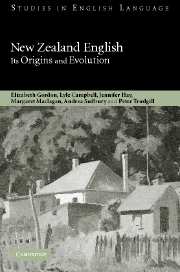Book contents
- Frontmatter
- Contents
- List of figures
- List of tables
- Acknowledgements
- List of abbreviations
- Symbols used
- 1 Introduction
- 2 Overview and background
- 3 The historical background
- 4 Previous attempts to explain the origins of New Zealand English
- 5 Methodology
- 6 The variables of early New Zealand English
- 7 The origins of New Zealand English: reflections from the ONZE data
- 8 Implications for language change
- Appendix 1 Mobile Unit speakers
- Appendix 2 The historical background of some settlements visited by the Mobile Unit
- Appendix 3 Maps
- Appendix 4 Seven Mobile Unit speakers born outside New Zealand
- Appendix 5 Acoustic vowel charts for the ten speakers included in the acoustic analysis
- Appendix 6 Speaker indexes for quantified variables, together with relevant social information
- References
- Index
- References
References
Published online by Cambridge University Press: 22 September 2009
- Frontmatter
- Contents
- List of figures
- List of tables
- Acknowledgements
- List of abbreviations
- Symbols used
- 1 Introduction
- 2 Overview and background
- 3 The historical background
- 4 Previous attempts to explain the origins of New Zealand English
- 5 Methodology
- 6 The variables of early New Zealand English
- 7 The origins of New Zealand English: reflections from the ONZE data
- 8 Implications for language change
- Appendix 1 Mobile Unit speakers
- Appendix 2 The historical background of some settlements visited by the Mobile Unit
- Appendix 3 Maps
- Appendix 4 Seven Mobile Unit speakers born outside New Zealand
- Appendix 5 Acoustic vowel charts for the ten speakers included in the acoustic analysis
- Appendix 6 Speaker indexes for quantified variables, together with relevant social information
- References
- Index
- References
- Type
- Chapter
- Information
- New Zealand EnglishIts Origins and Evolution, pp. 339 - 358Publisher: Cambridge University PressPrint publication year: 2004

